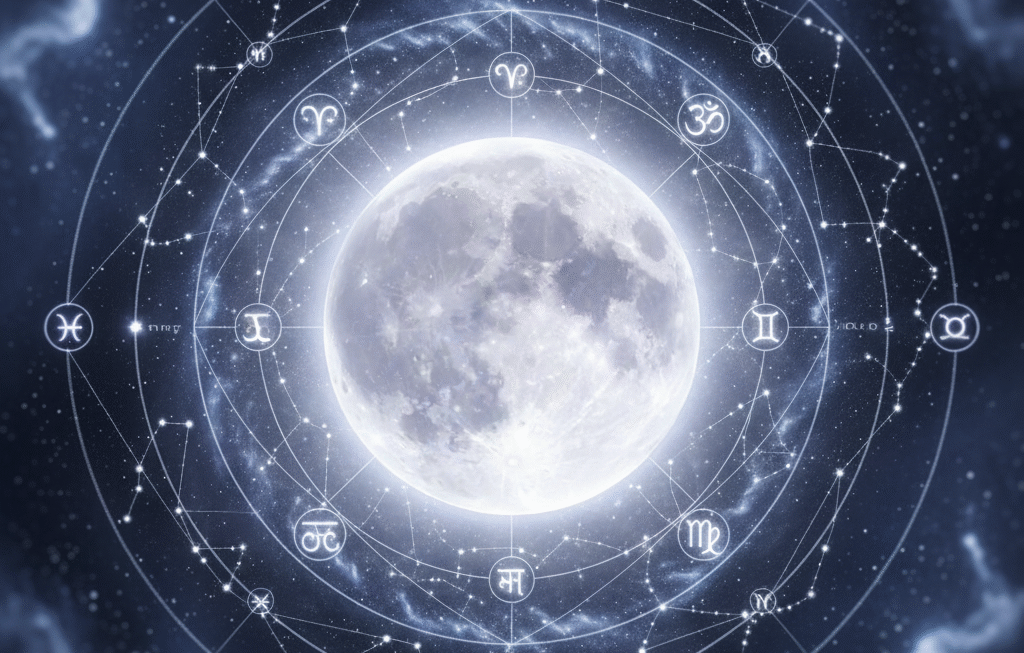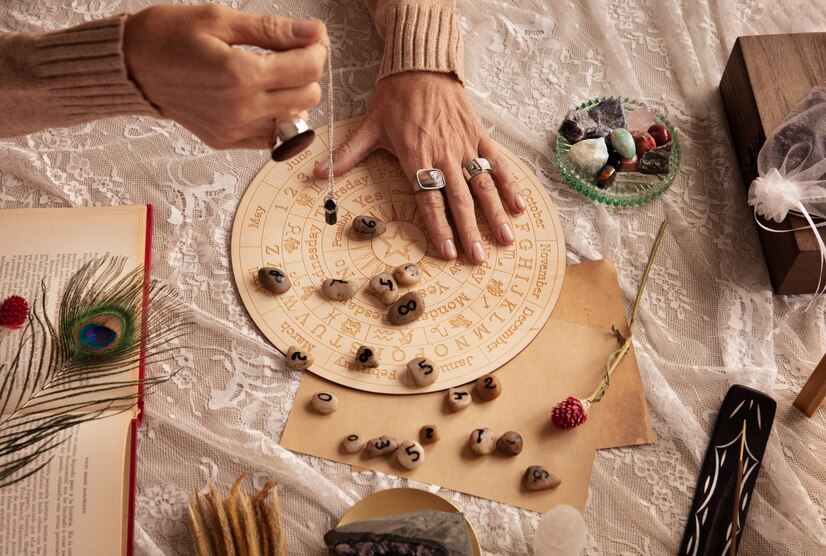If there’s one element that truly distinguishes Vedic astrology from other astrological systems, it’s the sophisticated dasha system—particularly the Vimshottari Dasha—that enables astrologers to time specific life events with remarkable precision. While Western astrology relies primarily on transits and progressions, Vedic astrology incorporates these powerful planetary periods that activate different energies throughout your lifetime, revealing when specific karmic patterns will ripen.
The Vimshottari Dasha system spans 120 years—the theoretical maximum human lifespan according to ancient Vedic wisdom—and divides this period into nine planetary subcycles. Your personal dasha sequence begins with the planet ruling the nakshatra (lunar mansion) where your Moon was positioned at birth. This starting point provides the key to unlocking when different planetary energies will predominate in your life journey, influencing everything from career achievements to relationship patterns.
In this comprehensive analysis, we’ll explore Vimshottari Dasha through multiple perspectives: its historical foundations in classical texts, modern psychological interpretations, practical learning methods, and real-world applications. Whether you’re a serious student of Vedic astrology or simply curious about this powerful predictive tool, this multi-dimensional exploration will provide valuable insights into how cosmic time cycles influence your individual destiny.
LENS 1: Historical & Traditional Foundation
The Traditional Astrologer’s View
The Vimshottari Dasha system is one of several dasha systems described in classical Vedic astrological texts, but it has become the most widely used due to its accuracy and comprehensive nature. The term itself reveals its essence: “Vimshottari” refers to the 120-year total cycle (derived from “vimsho” meaning twenty and “uttari” meaning beyond or plus one hundred).
“This system has been continuously used for thousands of years,” explains Pandit Vishnu Sharma, a traditional Vedic astrologer with over forty years of practice. “The earliest complete description appears in the Brihat Parashara Hora Shastra, composed approximately 2,000 years ago, though the principles likely date back much earlier.”
The 120-year cycle holds symbolic significance. According to ancient Vedic wisdom, this represents the ideal human lifespan when living in complete harmony with natural law. While few people actually live to 120, the system accommodates the full potential human lifecycle, with each planetary period reflecting different developmental stages and karmic expressions.
The Mathematical Precision of Planetary Periods
The Vimshottari system allocates specific year allotments to each of the nine planets:
- Sun: 6 years
- Moon: 10 years
- Mars: 7 years
- Rahu (North Node): 18 years
- Jupiter: 16 years
- Saturn: 19 years
- Mercury: 17 years
- Ketu (South Node): 7 years
- Venus: 20 years
Together, these periods total 120 years. The sequence always follows this fixed order, but the planet that begins your personal cycle depends on which nakshatra your Moon occupied at birth.
“This is where the nakshatra system interfaces with the dasha system,” notes Pandit Sharma. “Each of the 27 nakshatras is ruled by one of the nine planets. For example, if your Moon was in Ashwini nakshatra at birth, which is ruled by Ketu, your 120-year cycle begins with Ketu’s 7-year period, followed by Venus’s 20 years, and so on.”
Nested Time Cycles: The Hierarchy of Periods
The Vimshottari system operates with remarkable precision through its hierarchical structure:
- Mahadasha: The main planetary period (ranging from 6 to 20 years)
- Antardasha: Sub-periods within each Mahadasha
- Pratyantardasha: Sub-sub-periods within each Antardasha
- Sookshma-antardasha: Even finer divisions for precise timing
“Think of it like a set of nested Russian dolls,” explains Pandit Sharma. “Each level provides greater precision. The Mahadasha shows the general life themes for several years, while the Antardasha narrows the timing to months, and further subdivisions can pinpoint specific weeks or even days when significant events are likely to manifest.”
Traditional texts provide specific calculations for determining not just which dasha you’re experiencing, but precisely how far you are into that dasha at any given time. This allows for the creation of a detailed timeline of your entire life journey from birth, mapping out when different planetary energies will become prominent.
Traditional Interpretation Principles
Classical texts outline several factors that influence how a particular dasha will manifest:
- The inherent nature of the planet: Each planet carries specific significations (e.g., Saturn relates to career, discipline, and challenges; Venus to relationships, arts, and pleasures)
- The planet’s placement in the birth chart: The house position and sign determine which life areas will be most affected
- The planet’s dignity and strength: Whether the planet is exalted, debilitated, or in a friendly/enemy sign
- Aspects to the planet: Other planets aspecting or conjoining the dasha lord modify its expression
- The planet’s house lordship: Which houses the planet rules in the chart shapes how it manifests during its dasha
“The most skilled traditional astrologers can interpret these factors systematically to predict major life developments with remarkable accuracy,” notes Pandit Sharma. “However, this requires deep knowledge of classical principles and years of practical experience.”
LENS 2: Modern Interpretation Framework
The Modern Practitioner’s Approach
Contemporary Vedic astrologers have integrated psychological understanding with traditional dasha interpretation, creating a more nuanced framework that acknowledges both fate and free will. This modern approach recognizes that dashas reveal karmic patterns and potential outcomes, while also providing opportunities for conscious navigation and growth.
“I view the dasha system as a cosmic curriculum,” explains Dr. Anjali Patel, who combines traditional Vedic training with a background in developmental psychology. “Each planetary period brings certain lessons, challenges, and opportunities that contribute to your overall life development. How you respond to these energies involves choice, awareness, and personal evolution.”
Psychological Dimensions of Planetary Periods
Modern practitioners recognize that each planetary dasha activates both external circumstances and internal psychological states:
Sun Dasha (6 years): A period of identity development, leadership opportunities, and questions about authentic self-expression. Internally, it often brings focus to ego development, self-confidence, and relationship with authority and father figures.
Moon Dasha (10 years): Heightened emotional sensitivity, changes in home and family circumstances, and fluctuating circumstances. Internally, it activates the subconscious mind, emotional patterns, and mother-related psychological material.
Mars Dasha (7 years): Increased energy, competition, potential conflicts, and initiatives requiring courage. Psychologically, it brings attention to anger management, assertiveness, and channeling passionate drives constructively.
Rahu Dasha (18 years): Often brings unusual circumstances, worldly ambitions, and experiences outside one’s cultural comfort zone. On the psychological level, it activates desires, obsessions, and the shadow aspects of personality seeking integration.
Jupiter Dasha (16 years): Expansion, higher education, children, and philosophical or spiritual growth. Internally, it relates to belief systems, meaning-making, and the development of wisdom and ethical understanding.
Saturn Dasha (19 years): Professional responsibilities, limitations, delays, and important structure-building. Psychologically, it activates the reality principle, facing fears, developing discipline, and coming to terms with time and mortality.
Mercury Dasha (17 years): Communication activities, education, commerce, and analytical projects. Internally, it relates to cognitive development, information processing, and nervous system regulation.
Ketu Dasha (7 years): Spiritual insights, detachment from material concerns, and unusual or isolated circumstances. Psychologically, it relates to releasing attachments, dissolving ego boundaries, and accessing intuitive wisdom.
Venus Dasha (20 years): Relationships, pleasures, comforts, arts, and social harmony. Internally, it activates the capacity for intimacy, aesthetic appreciation, and value clarification.
“Understanding these psychological dimensions allows for more empowering guidance,” notes Dr. Patel. “Rather than simply predicting external events, we can help clients recognize the inner work each dasha period invites.”
Case Study: Multiple Expressions of Saturn Dasha
To illustrate the range of manifestations possible during a specific dasha, Dr. Patel offers a case study of three different individuals experiencing Saturn Mahadasha:
Client A (Saturn well-placed in 10th house, own sign): Experienced significant career advancement, taking on leadership roles with increasing responsibility. The psychological journey involved overcoming imposter syndrome and embracing authority.
Client B (Saturn debilitated in 6th house): Faced health challenges requiring lifestyle discipline and routine. Career progress came through service-oriented roles and overcoming obstacles. The psychological journey involved making peace with limitations and developing resilience.
Client C (Saturn in 12th house with Jupiter aspect): Entered a spiritually focused period with withdrawal from worldly ambitions, including time in retreat settings. Career shifted toward teaching and counseling. The psychological journey involved surrendering control and developing faith during uncertainty.
“These variations show how the same planetary period manifests differently based on the birth chart,” explains Dr. Patel. “The key aspects of Saturn energy—responsibility, structure, time, limitations—were present in all cases, but expressed through different life areas and with different quality of experience.”
LENS 3: Learning Path Analysis
The Student’s Journey
For students of Vedic astrology, the dasha system often represents both the most exciting and most challenging aspect to master. The promise of precise timing makes it compelling, while the complexity of calculations and interpretive principles can seem overwhelming.
“When I first encountered Vimshottari Dasha, I was simultaneously fascinated and intimidated,” admits Rohan Mehta, who has dedicated five years to studying Vedic astrology. “The breakthrough came when I stopped trying to memorize everything at once and instead focused on understanding my own chart’s dasha sequence as a case study.”
Step-by-Step Learning Approach
Based on the experience of successful students, the following progressive approach emerges:
1. Master the Basics First
“Before diving into dasha interpretation, ensure you have solid foundation knowledge,” advises Mehta. This includes:
- Understanding the significations of the nine planets
- Knowing how house placements modify planetary expressions
- Grasping how aspects between planets create relationships
- Comprehending the nakshatra system, especially nakshatra rulerships
- 2. Calculate Your Personal Dasha Sequence
Begin by calculating your own Vimshottari Dasha sequence, identifying:
- Which nakshatra your Moon occupied at birth
- The ruling planet of that nakshatra, which begins your 120-year cycle
- Where in that planetary period you began life (calculated precisely from birth time)
- The sequence of Mahadashas throughout your life
- Which Mahadasha and Antardasha you’re currently experiencing
“Working with your own chart creates immediate relevance and helps the learning stick,” notes Mehta. “I created a timeline of my life and noted significant events, then correlated them with the dashas I was experiencing at those times.”
3. Develop a Systematic Interpretation Framework
After calculating the dashas, develop a systematic approach to interpretation:
- Analyze the condition of the dasha lord in the birth chart
- Identify which houses it rules and occupies
- Note any planets conjoining or aspecting it
- Consider its relationship with other key planets in the chart
- Review relevant divisional charts (especially for marriage, career, etc.)
“I created a worksheet template that I still use for every dasha analysis,” shares Mehta. “It ensures I don’t miss important factors and helps me see patterns across different dashas.”
4. Study Case Examples and Retrospective Analysis
One of the most effective learning methods is to study how dashas have manifested in real lives:
- Analyze your own life retrospectively, correlating events with past dashas
- Study biographies of well-known individuals with known birth data
- Work with friends and family members who can verify life events
- Join study groups where members share chart analyses and feedback
“Retrospective analysis builds confidence in the system and your interpretive skills,” explains Mehta. “When you see how accurately past dashas reflected life developments, you gain trust in the predictive power of the technique.”
Common Questions and Challenges
Students typically encounter several recurring questions when learning the dasha system:
Q: How can I calculate dashas without specialized software? A: While software makes the process much easier, traditional calculation methods use proportional mathematics based on the Moon’s precise position within a nakshatra. Many modern students use software for calculations but learn the traditional methods to understand the underlying principles.
Q: How specific can dasha predictions be? A: The specificity depends on how deeply you analyze the subdivisions. Mahadasha gives general life themes for several years, while analyzing down to Pratyantardasha can narrow timing to weeks. However, specificity also depends on the astrologer’s skill and experience in interpreting multiple factors.
Q: What if my birth time is uncertain? A: Birth time uncertainty can significantly impact dasha calculations, as even a few minutes’ difference can change the Moon’s nakshatra position. In such cases, astrologers use rectification techniques, working backward from known life events to confirm the correct birth time and dasha sequence.
Q: How do I reconcile contradictory indications? A: This is perhaps the most challenging aspect of dasha interpretation. When the dasha lord shows mixed indications (e.g., well-placed but afflicted), students learn to synthesize these factors into a nuanced prediction rather than expecting uniformly positive or negative outcomes.
LENS 4: Practical Implementation
The Practical Application Expert’s Guidance
Beyond theoretical understanding, the dasha system offers powerful practical applications for navigating life more consciously. Priya Sharma, who specializes in applied Vedic astrology for life coaching, shares strategies for using dasha awareness for proactive life management.
“Knowing your dasha sequence is like having a weather forecast for different seasons of your life,” explains Sharma. “It doesn’t control what happens, but it allows you to prepare appropriately—bringing an umbrella when rain is likely, or sunscreen when intense heat is predicted.”
Strategic Life Planning Based on Dasha
One of the most valuable applications is aligning major life decisions with favorable dasha periods:
“I work with clients to create what I call a ‘Dasha-Aligned Life Strategy,'” shares Sharma. “This involves mapping out the next 10-15 years of planetary periods and identifying the optimal timing for major initiatives.”
This strategic approach includes:
- Identifying Supportive Periods for Specific Goals:
Career advancement initiatives during strong 10th lord dashas
Relationship commitments during favorable Venus or 7th lord periods
Educational pursuits during supportive Mercury or Jupiter dashas
Family planning during auspicious Moon or 5th lord periods - Preparation for Challenging Periods:
Building financial reserves before difficult economic periods
Strengthening health routines before potentially challenging health transits
Developing support systems before periods of potential isolation
Creating stability before dashas that indicate change and upheavalMaximizing Growth Opportunities:
Scheduling personal development during self-reflective periods
Planning spiritual retreats during introspective dashas
Focusing on relationship healing during Venus or Moon periods
Developing communication skills during Mercury periods
“This isn’t about avoiding challenges,” clarifies Sharma. “Rather, it’s about conscious timing and preparation. Sometimes the most growth comes during difficult periods, but awareness allows you to extract the wisdom without being completely overwhelmed.”
Navigating Current Dasha Periods Effectively
For immediate practical benefit, Sharma offers guidance on working constructively with whatever dasha you’re currently experiencing:
During Sun Periods: Focus on authentic self-expression, leadership development, and building relationships with authority figures or mentors. Pay attention to father-related issues that may need healing.
During Moon Periods: Prioritize emotional well-being, create nurturing home environments, and strengthen family connections. Consider working with a therapist to address subconscious patterns.
During Mars Periods: Channel energy constructively through physical exercise, develop healthy assertiveness, and be strategic about which battles are worth fighting. Practice patience during potential conflicts.
During Rahu Periods: Be discerning about ambitions and desires, as they intensify during this period. Explore unfamiliar territories but maintain ethical boundaries. Monitor tendencies toward obsession or excess.
During Jupiter Periods: Expand knowledge through education, travel, or spiritual studies. Mentor others and share wisdom. Be mindful of potential overextension or overoptimism.
During Saturn Periods: Focus on building long-term structures, accept necessary responsibilities, and develop patience with slower timelines. Create sustainable routines and practice self-discipline.
During Mercury Periods: Develop communication skills, pursue intellectual interests, and stay organized amid potentially scattered energy. Practice mindfulness to manage mental restlessness.
During Ketu Periods: Embrace simplicity, create space for spiritual practice, and be willing to release what no longer serves your evolution. Accept periods of isolation as opportunities for inner growth.
During Venus Periods: Cultivate meaningful relationships, develop artistic talents, and clarify personal values. Balance pleasure-seeking with deeper commitment to what truly matters.
“The key is working with the energy rather than against it,” emphasizes Sharma. “Each dasha brings certain gifts and challenges. By aligning your focus with the natural tendencies of the period, you can maximize growth and minimize struggle.”
Remedial Measures for Challenging Dashas
Vedic astrology offers various remedial measures to harmonize challenging planetary energies:
- Mantra Recitation: Specific sound formulas that resonate with and balance planetary energies
- Gemstone Therapy: Wearing stones corresponding to beneficial planets
- Charitable Actions: Specific donations associated with each planet
- Spiritual Practices: Meditations and rituals to elevate consciousness during difficult periods
- Lifestyle Adjustments: Modifications to daily routines, diet, and habits
“These remedies aren’t meant to ‘cancel’ karma,” clarifies Sharma, “but rather to raise your level of consciousness so you can respond more wisely to whatever circumstances arise. The highest remedy is always awareness itself.”
PERSPECTIVE INTEGRATION MATRIX
The four perspectives we’ve explored complement each other to create a holistic understanding of the Vimshottari Dasha system:
| Perspective | Key Contribution | Complements Other Views By |
| Traditional | Mathematical precision and classical interpretation principles | Providing authentic foundation for modern adaptations |
| Modern | Psychological dimension and integration with contemporary life | Making ancient wisdom relevant to today’s circumstances |
| Student | Practical learning path and common challenges | Creating accessibility to complex knowledge |
| Practical | Real-world application strategies | Translating theoretical knowledge into life benefits |
MISCONCEPTION ANALYSIS
Several common misconceptions about the dasha system deserve clarification:
Misconception: Dashas rigidly determine fate, leaving no room for free will.
Reality: Dashas reveal karmic patterns and potentials that can manifest across a spectrum of possibilities, influenced by awareness and choices.
Misconception: “Good” planets always bring positive dashas and “bad” planets bring difficulties.
Reality: Each planet brings a mix of challenges and opportunities based on its placement, aspects, and the individual’s level of consciousness.
Misconception: Dasha effects are uniform throughout the entire period.
Reality: The intensity and expression vary throughout the period, especially as different antardashas (sub-periods) activate.
Misconception: Modern life is too different from ancient times for dashas to remain relevant.
Reality: While external circumstances have changed, core human experiences related to relationships, work, spirituality, and personal development remain relevant across time.
KEY DEVELOPMENTS & FUTURE DIRECTIONS
The study and application of the Vimshottari Dasha system continues to evolve:
- Integration with Western Techniques: Some contemporary astrologers are exploring how dasha analysis can complement Western predictive techniques like progressions and solar arcs.
- Psychological Research: Preliminary studies are examining correlations between psychological development stages and dasha periods.
- Statistical Analysis: Research projects are collecting data on how specific dashas correlate with life events across large sample groups.
- Technological Innovations: Advanced software now offers detailed dasha timelines with interpretive guidance, making this knowledge more accessible.
- Cross-Cultural Applications: The dasha system is being adapted for use in diverse cultural contexts while maintaining its core principles.“The field is expanding in exciting ways,” notes Dr. Patel. “The mathematical foundation remains constant, but our understanding of how dashas manifest in modern contexts continues to deepen.”
SYNTHESIS & RECOMMENDATIONS
For those seeking to work effectively with the Vimshottari Dasha system, the following integrated approach is recommended:
- Know Your Current Position: Calculate your present Mahadasha and Antardasha, and understand where these planets are placed in your birth chart.
- Analyze Multiple Factors: Consider the dasha lord’s nature, placement, aspects, strengths, and house rulership to develop a nuanced understanding of its likely manifestation.
- Balance Fate and Free Will: Use dasha knowledge not to predict fixed outcomes but to understand the energetic themes and potentials of each period.
- Develop Planetary Wisdom: Learn the higher expressions of each planetary energy to navigate its periods more consciously.
- Create a Dasha Timeline: Map out your dasha sequence for the next several years to enable strategic life planning.
- Practice Remedial Measures: Implement appropriate remedies for challenging dasha periods while maintaining realistic expectations.
- Regular Review and Reflection: Periodically review how dashas have manifested in your life to refine your understanding of your unique chart patterns.FURTHER AREAS OF STUDY
For those interested in deepening their understanding of Vedic time cycles, several related areas offer valuable insights:
- Alternative Dasha Systems: Explore other predictive systems like Yogini Dasha, Kalachakra Dasha, or Chara Dasha, each with unique applications.
- Transit Interactions: Study how transiting planets activate or modify dasha expressions when they aspect the dasha lord.
- Divisional Chart Analysis: Examine how dashas manifest through relevant divisional charts (varga charts) for specific life areas.
- Ashtakavarga System: Learn how this bindu (point) system modifies and refines dasha predictions.
- Advanced Timing Techniques: Study the combination of dashas with transits, solar returns, and varshaphal (annual charts) for precise timing.
The Vimshottari Dasha system represents one of the most profound contributions of Vedic astrology to our understanding of how cosmic time cycles influence human experience. By integrating traditional wisdom with contemporary insights, we can use this ancient knowledge to navigate our modern lives with greater awareness, purpose, and harmony.












